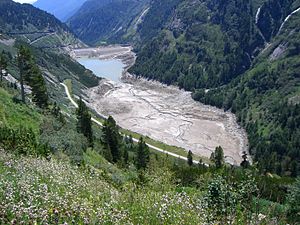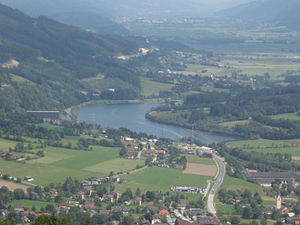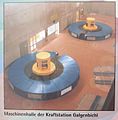Malta power plants
The Malta power plants are a group of hydropower plants in the Austrian state of Carinthia , consisting of the upper level with the Kölnbrein storage facility (Austria's largest storage facility) and the main and lower level. The operator is Verbund Hydro Power GmbH, a subsidiary of Verbund AG .
Together with the Reißeck-Kreuzeck power plant group and the Reißeck II power plant , which has been connecting the systems hydraulically since 2016, the Malta power plants form the Malta-Reisseck power plant group .
history
The painting project took decades of preparation, characterized by different variants. As early as the 1930s, the Allgemeine Elektrizitätsgesellschaft and subsequently the Alpen-Elektrowerke AG dealt with the possible uses of the drains of the Malta Valley . In the course of the construction of the Zwentendorf nuclear power plant, a large failure reserve was necessary, so that this project was implemented in parallel. As with the nuclear power plant, Energie AG Oberösterreich took part in this project. This participation is still present today.
In the early 1950s , Österreichische Draukraftwerke AG continued its studies as part of the reorientation of the electricity industry. The water and energy studies showed that the Inner Malta Valley is one of the areas with the highest rainfall in Carinthia . The catchment area has strong glaciations, which represent a valuable runoff reserve in dry summers. It is also influenced by the weather both north and south of the main Alpine ridge.
On the basis of comparative studies, the nearby Reißeck-Kreuzeck winter storage power station , which was then under construction , was to be expanded by adding a number of tributaries to Malta. The result was finally in the form of a ready-to-build project to use the Malta and the large streams in a separate, three-stage group of power stations.
From 1957, geologists examined the subsoil and valley flanks at the planned location of the Kölnbrein Dam. Bores up to 80 m deep showed the rock as a stable base and abutment for the largest dam in Austria, which was poured from 1.6 million m³ of concrete between 1971 and 1978: a horizontally and vertically curved vaulted wall that was 90 degree tilted, flat dome is splayed against the solid rock.
This design principle manages with considerably less building mass (concrete) than any other dam of the same stability (which withstands almost six times the pressure of the water when fully dammed) and thus also saves construction costs. In 1979, the Kölnbrein Reservoir reached full water levels for the first time, exposing the dam to a total force of 5.4 million tons due to the water pressure and deforming it at the top of the dam by 12 cm out of the valley as planned.
In 1978 around 400 built-in measuring points signaled problems: water pushed through cracks at the base of the highest barrier blocks. According to the experts, the cause: Overstressing of the barrier concrete along the contact area as a result of the horizontal component of the water pressure acting in this area, reinforced by an unexpectedly large difference in the deformation behavior of the dam and the rock.
In a complex process, the wall was from 1989 to 1992 after a project of the Swiss lock expert Giovanni Lombardi and after approval by the storage tank Commission rehabilitated: On the valley side a 65 m high and 70 m wide support vaults 500,000 cubic meters of concrete and 150,000 m³ bulk was built. The cracks on the water side were sealed with cement and synthetic resin injections. The front structure, which is arranged on the air side, relieves the barrier by around 22 percent of the water pressure that acts in the event of a full block. With this renovation, the construction costs for the Malta power plant group increased by an additional 2 billion schillings (around 145 million euros). On October 4, 1993, the full damming was finally reached again at altitude 1902 m - and all measuring points of the dam, which had been expanded to 2,500 up to that point, indicated the stability of the structure.
Until 2014, additional ecological measures were carried out as part of the Carinthian project "Habitat Water", which has existed since 2003 . The Rottau compensation basin was reconnected to the lower Möll via a fish ladder and the banks of the Sachsenweg Canal were planted with natural greenery.
In an expansion completed in 2016, the Reißeck II underground cavern power plant was built, thereby hydraulically connecting the Malta power plants to the Reißeck-Kreuzeck power plant group. The Great Mühldorfer See acts as the upper reservoir and the communicating Gößkar and Galgenbichl reservoirs act as the lower reservoir in weekly storage operation.
- The Sachsenweg Canal before and after the greening.
Energy-economic importance
The great adaptability of the power plant use to short, medium and long-term fluctuations in demand is the most important quality feature of the Malta power plant group.
While 91 percent of the water supply occurs in the lower summer half-year and only nine percent in the winter half-year, the annual storage can increase the generation share in the winter half-year from nine percent (from natural inflow) to 78.3 percent. A rolling operation contributes to a further balance of demand and supply in the short and medium term. In rolling operation, if there is an excess of power, water can be pumped up from the Möll into the storage tank in the main stage and from the Galgenbichl storage tank into the Kölnbrein storage tank, in order to be processed at peak load times. The output range between 406 megawatts of pump output and 891 megawatts of turbine output thus amounts to a total of 1,297 megawatts or around twelve percent of the peak load in Austria. This means that KW Malta can quickly adapt the electrical output in the network to the respective requirements. Due to its high performance and rapid availability, Malta is able to provide valuable support in the event of power plant failures, not only in Austria but also beyond its borders.
Upper school
The upper stage consists of the Kölnbrein reservoir, the Kölnbreinsperre and the associated Galgenbichl power station.
| Kölnbrein storage facility | |||
|---|---|---|---|
| Kölnbrein storage facility as seen from Arlhöhe. In the background the Galgenbichl storage facility. | |||
|
|
|||
|
|
|||
| Coordinates | 47 ° 4 '50 " N , 13 ° 20' 35" E | ||
| Data on the structure | |||
| Construction time: | 1971-77, 1989-92 | ||
| Height of the barrier structure : | 200 m | ||
| Height above foundation level : | 302 m | ||
| Building volume: | 2.04 million m³ | ||
| Crown length: | 626 m | ||
| Crown width: | 7.6 m | ||
| Base width: | 41 m | ||
| Power plant output: | 120 MW | ||
| Data on the reservoir | |||
| Altitude (at congestion destination ) | 1902 m above sea level A. | ||
| Water surface | 2.55 km² | ||
| Reservoir length | 4.5 km | ||
| Storage space | 200 million m³ | ||
| Catchment area | 51.3 km² | ||
| Galgenbichl pre-storage facility | |||
|---|---|---|---|
| Galgenbichl storage tank (emptied for maintenance work) | |||
|
|||
|
|
|||
| Coordinates | 47 ° 3 '59 " N , 13 ° 21' 9" E | ||
| Data on the structure | |||
| Height of the barrier structure : | 50 m (dam) and 15 m (wall) | ||
| Building volume: | 175,000 m³ (dam), 6500 m³ (wall) | ||
| Crown length: | 115 m (dam), 85 m (wall) | ||
| Data on the reservoir | |||
| Altitude (at congestion destination ) | 1704 m above sea level A. | ||
| Storage space | 4.4 million m³ | ||
| Catchment area | 77.3 km² | ||
| Gößkar compensation reservoir | |||
|---|---|---|---|
| Gößkarspeicher | |||
|
|
|||
|
|
|||
| Coordinates | 46 ° 58 ′ 58 ″ N , 13 ° 19 ′ 52 ″ E | ||
| Data on the structure | |||
| Construction time: | 1971-79 | ||
| Height of the barrier structure : | 55 m | ||
| Building volume: | 520,000 m³ | ||
| Crown length: | 260 m | ||
| Crown width: | 5 m | ||
| Base width: | 175 m | ||
| Data on the reservoir | |||
| Altitude (at congestion destination ) | 1704 m above sea level A. | ||
| Storage space | 1.8 million m³ | ||
| Rottau compensation basin | |||||||
|---|---|---|---|---|---|---|---|
| Rottau reservoir seen from Danielsberg | |||||||
|
|||||||
|
|
|||||||
| Coordinates | 46 ° 51 ′ 49 ″ N , 13 ° 20 ′ 6 ″ E | ||||||
| Data on the structure | |||||||
| Construction time: | 1971-79 | ||||||
| Height of the barrier structure : | 13.7 m | ||||||
| Crown length: | 2 × 15 m | ||||||
| Power plant output: | 41 MW | ||||||
| Data on the reservoir | |||||||
| Altitude (at congestion destination ) | 598 m above sea level A. | ||||||
| Storage space | 500,000 m³ | ||||||
Kölnbrein storage facility
The Kölnbrein storage facility is the core of the Malta power plants. The area that drains directly into the reservoir is not enough by itself to completely fill the annual reservoir . For this reason, the tributaries of the Obere Lieser and some streams in the area of the Malta and Gößtal valley at around 1700 m above sea level are collected and stored in the Galgenbichl reservoir. From there they are pumped into the Kölnbrein storage facility, which is around 200 m higher. In addition, water from the Möll is pumped up around 1300 m and used to fill the reservoir.
The water surface is at full damming at 1902 m above sea level. A. and can be lowered to 1750 m . A full storage facility provides the Malta power plants with an energy content of 588.3 GWh .
The dam is a double-curved arch dam with a supporting vault on the air side. 2,500 measuring points, 800 of which have a direct connection to a process computer, monitor the dam.
Galgenbichl power plant
The Galgenbichl pumped storage power plant uses the water from the Kölnbrein reservoir to generate electricity in turbine mode, while excess energy is used to pump water from the Galgenbichl reservoir back to the Kölnbrein reservoir for energy storage.
Two Isogyre pump turbines are set up vertically in the power plant . Each turbine drives a generator with a nominal apparent power of 70 MVA. With an average raw head of 198 m and a flow capacity of 70 m³ / s, they can either deliver up to 120 MW of electrical power or take up to 116 MW from the network and use it to pump up the Kölnbrein storage facility. The annual standard work capacity is 76.0 million kWh. The power plant was put into operation in 1977/1978.
Main level
The main stage of the Malta power station consists of the Galgenbichl storage facility, the Gößkar storage facility and the Rottau power station.
Galgenbichl pre-storage facility
The water that has already been used from the Kölnbrein reservoir and feed lines from high-alpine streams are collected in the Galgenbichl reservoir . This has two barriers, a gravel embankment with asphalt concrete surface seal and a concrete weight wall.
Gößkar compensation reservoir
Additional storage capacity is provided by the Gößkar storage facility, which is connected through communication and around 10 km away . This is also much closer to the pressure tunnel leading to the power plant, so that unnecessary flow height losses in the 9.4 km long Malta tunnel can be avoided.
Rottau power plant
The machines of the Malta main stage Rottau in Kolbnitz im Mölltal are driven by water with extraordinarily high pressure, which comes from the reservoirs 1,100 m higher. From the Gößkar reservoir, the water route leads through the 9.7 km long Göß and Hattenberg tunnels and in a 1850 m long, two-strand penstock to the power plant.
The power plant has 4 six-jet Pelton turbines in a vertical arrangement. They drive four generators with a nominal output of 220 MVA each. Two of the generators are motor-generators that supply the two four-stage, single-flow radial pumps . With an average pipe head of 1106 m and a flow capacity of 80 m³ / s, either up to 730 MW of electrical power can be supplied or up to 290 MW can be returned to the storage tank by pumping up (nominal power). The annual standard work capacity is 715.0 million kWh.
After power station flushes, fish died in the Möll in 2009 and 2015 .
Lower level
Mölltal power plant
In the Malta power plant, the water is used for the third time within the Malta power plants to generate electrical energy .
The processed water from the main stage and water from the Möll are located in the Rottau compensation basin. At least 5 m³ / s of this water flow into the Möll either via the Rottau weir system or through a propeller turbine with a nominal output of 630 kW . All other water reaches the Möllbrücke power station through the open, around 2.5 km long upper water canal and the Sachsenweg tunnel, with a drop height of 45 m and a flow rate of 110 m³ / s. This is 3.9 km as the crow flies from the beginning and 1.2 km from the end of the upper water canal. There it is processed by two Kaplan turbines with a vertical shaft. The annual standard work capacity is 120.0 million kWh.
The water reaches the Drau before the actual Möll estuary , where it is used again for energy purposes in Carinthia's ten run-of- river power stations . The Möll loses a considerable amount of water via the headwater channel, which is why only a fraction flows into the Drau via the natural river bed.
Tourist importance
In addition to the energy industry, the Kölnbrein reservoir is also of particular touristic importance.
The 14.3 km long Malta High Alpine Road leads past spectacular waterfalls, which dry up at night as the water is diverted into the reservoirs. A tunnel leads to the mountain restaurant and Hotel Malta, right next to the Kölnbreinsperre. In addition to a restaurant and 60 beds, the tower-like building also houses an information show about the power plant group, a mineral show and an information show about the Hohe Tauern National Park.
It serves as a starting point for hikes and mountain tours. Bungee jumping is also organized from the top of the wall . The up to 4.3 km long reservoir is also used in the summer months by the rowers from the Germany eighth for altitude training in preparation for World Championships and Olympic Games.
See also
- Reisseck-Kreuzeck power plant group
- Kaprun power plant
- List of tallest structures in Austria
- List of reservoirs in Austria
- List of Austrian power plants
literature
- Gerhard A. Stadler, Manfred Wehdorn , Monika Keplinger, Valentin E. Wille: Architektur im Verbund (= series of research in Verbund 100). Springer Verlag, Vienna et al. 2007, ISBN 978-3-211-75795-6 .
Web links
- Malta Main Stage Power Plant website
- Website for the Malta lower level power plant
- Website for the Malta Upper Level Power Plant
- Website for the visitor center Kölnbreinsperre
- Information on the Reisseck website
Individual evidence
- ↑ Reisseck 2 pumped storage power plant on verbund.com, accessed on January 28, 2020
- ↑ Thousands of fish in Möll perished orf.at, accessed on October 10, 2015
- ↑ After fish deaths on the Möll, the authority checks kleinezeitung.at
































